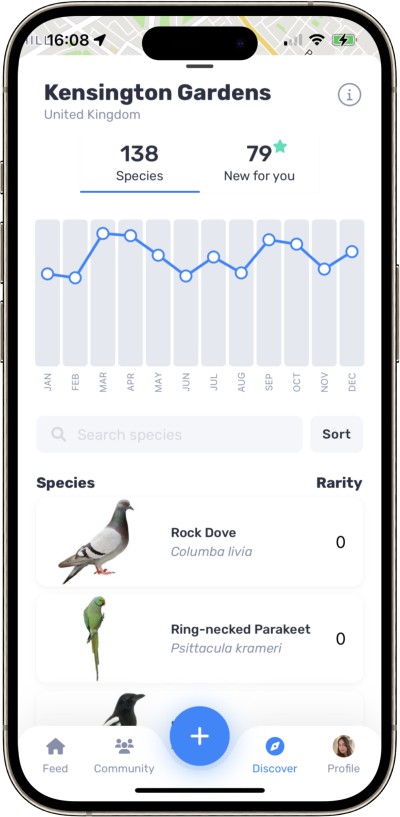loading...
Antbirds
The antbird family, Thamnophilidae, consists of over 230 species scattered across Central and South America, inhabiting mainly forested areas. These species vary in size and are often sexually dimorphic, showing differences in plumage between males and females, with colors typically ranging from grey, white, brown, and rufous. Known for their strong legs and stout bills, many antbirds follow swarms of army ants to feed on the insects these ants disturb. Small, rounded wings allow them to maneuver in dense forests where they're found from the understory to the canopy or on the forest floor. These birds are monogamous, mate for life, and are pivotal parts of mixed-species feeding flocks, some of which are central to the flock's cohesion. Antbirds lay typically two eggs per clutch and share parental duties such as incubation and feeding the chick post-fledging. While antbirds are not threatened by hunting or trade, habitat loss poses a significant threat, causing many species to face extinction risks. Studies of their genetic makeup and morphological traits have greatly informed our understanding of their evolution and classification, as DNA analysis confirms their placement in the larger taxonomy of birds.
The complex behaviors and feeding strategies, such as ant-following and participating in mixed-species flocks, highlight the adaptability and ecological roles of antbirds. Despite this, antbirds face challenges in fragmented habitats, where they suffer from increased predation and potential local extinctions. Nonetheless, research and conservation efforts continue, leading to the discovery of new species and preservation initiatives, such as relocating individuals threatened by habitat disturbance.
Regions
Categories
All
African & New World Parrots
Albatrosses
Anhingas, Darters
Antbirds
Antpittas
Antthrushes
Austral Storm Petrels
Barn Owls
Black-capped Donacobius
Caracaras, Falcons
Cardinals & Allies
Chachalacas, Curassows, Guans
Chats, Old World Flycatchers
Cormorants, Shags
Cotingas
Crescentchests
Crows, Jays
Cuckoos
Dippers
Ducks, Geese, Swans
Finches, Euphonias
Finfoots
Flamingos
Frigatebirds
Gannets, Boobies
Gnatcatchers
Gnateaters
Grebes
Gulls, Terns, Skimmers
Herons, Bitterns
Hoatzin
Hummingbirds
Ibises, Spoonbills
Jacamars
Jacanas
Kingfishers
Kites, Hawks, Eagles
Larks
Limpkin
Magellanic Plover
Manakins
Mitrospingid Tanagers
Mockingbirds, Thrashers
Motmots
New World Barbets
New World Quail
New World Sparrows
New World Vultures
New World Warblers
Nightjars
Northern Storm Petrels
Oilbird
Old World Parrots
Old World Sparrows, Snowfinches
Oropendolas, Orioles, Blackbirds
Ospreys
Ovenbirds
Owls
Oystercatchers
Painted-snipes
Pelicans
Penguins
Petrels, Shearwaters, Diving Petrels
Pheasants & Allies
Pigeons, Doves
Plovers
Potoos
Puffbirds
Rails, Crakes & Coots
Rheas
Sandpipers, Snipes
Sapayoa
Screamers
Seedsnipes
Seriemas
Sheathbills
Skuas
Starlings, Rhabdornis
Stilts, Avocets
Stone-curlews, Thick-knees
Storks
Sunbittern
Swallows, Martins
Swifts
Tanagers & Allies
Tapaculos
Thrushes
Thrush-tanager
Tinamous
Tityras, Becards, Sharpbill
Toucan Barbets
Toucans
Trogons
Tropicbirds
Trumpeters
Tyrant Flycatchers, Calyptura
Vireos, Greenlets, Shrike-babblers
Wagtails, Pipits
Waxbills, Munias & Allies
Waxwings
Weavers, Widowbirds
Woodpeckers
Wrens
Acre Antshrike
Thamnophilus divisorius
Alagoas Antwren
Myrmotherula snowi
Allpahuayo Antbird
Percnostola arenarum
Amazonian Antshrike
Thamnophilus amazonicus
Amazonian Streaked Antwren
Myrmotherula multostriata
Ancient Antwren
Herpsilochmus gentryi
Aripuana Antwren
Herpsilochmus stotzi
Ash-breasted Antbird
Myrmoborus lugubris
Ash-throated Antwren
Herpsilochmus parkeri
Ash-winged Antwren
Euchrepomis spodioptila
Bahia Antwren
Herpsilochmus pileatus
Bamboo Antshrike
Cymbilaimus sanctaemariae
Bananal Antbird
Cercomacra ferdinandi
Banded Antbird
Dichrozona cincta
Band-tailed Antbird
Hypocnemoides maculicauda
Band-tailed Antshrike
Thamnophilus melanothorax
Band-tailed Antwren
Myrmotherula urosticta
Bar-crested Antshrike
Thamnophilus multistriatus
Bare-crowned Antbird
Gymnocichla nudiceps
Bare-eyed Antbird
Rhegmatorhina gymnops

Barred Antshrike
Thamnophilus doliatus
Bertoni's Antbird
Drymophila rubricollis

Bicolored Antbird
Gymnopithys bicolor
Bicolored Antvireo
Dysithamnus occidentalis
Black-and-white Antbird
Myrmochanes hemileucus
Black Antbird
Cercomacroides serva
Black Antshrike
Thamnophilus nigriceps
Black-backed Antshrike
Thamnophilus melanonotus
Black-bellied Antwren
Formicivora melanogaster
Black Bushbird
Neoctantes niger
Black-capped Antwren
Herpsilochmus atricapillus
Black-chinned Antbird
Hypocnemoides melanopogon
Black-crested Antshrike
Sakesphorus canadensis

Black-crowned Antshrike
Thamnophilus atrinucha
Black-faced Antbird
Myrmoborus myotherinus
Black-headed Antbird
Percnostola rufifrons
Black-hooded Antwren
Formicivora erythronotos
Blackish Antbird
Cercomacroides nigrescens
Blackish-grey Antshrike
Thamnophilus nigrocinereus
Black-spotted Bare-eye
Phlegopsis nigromaculata
Black-tailed Antbird
Myrmoborus melanurus
Black-throated Antbird
Myrmophylax atrothorax
Black-throated Antshrike
Frederickena viridis
Blue-lored Antbird
Percnostola immaculata
Bluish-slate Antshrike
Thamnomanes schistogynus
Bolivian Slaty Antshrike
Thamnophilus sticturus
Brown-bellied Stipplethroat
Epinecrophylla gutturalis
Brownish-headed Antbird
Myrmelastes brunneiceps
Your birdwatching journey like never before
Connect with nature in minutes
Take a walk, look out of the window and log the birds that you see. Feel good about those little connections to nature.
Discover the joy of birding
Find new birding spots, see more birds, share and celebrate with a like-minded community of nature lovers.
Play your part in saving nature
Logging your birding sightings and sessions turns into positive action for our planet. Every sighting counts.
Species Categories
African & New World ParrotsAlbatrossesAnhingas, DartersAntbirdsAntpittasAntthrushesAustral Storm PetrelsBarn OwlsBlack-capped DonacobiusCaracaras, FalconsCardinals & AlliesChachalacas, Curassows, GuansChats, Old World FlycatchersCormorants, ShagsCotingasCrescentchestsCrows, JaysCuckoosDippersDucks, Geese, SwansFinches, EuphoniasFinfootsFlamingosFrigatebirdsGannets, BoobiesGnatcatchersGnateatersGrebesGulls, Terns, SkimmersHerons, BitternsHoatzinHummingbirdsIbises, SpoonbillsJacamarsJacanasKingfishersKites, Hawks, EaglesLarksLimpkinMagellanic PloverManakinsMitrospingid TanagersMockingbirds, ThrashersMotmotsNew World BarbetsNew World QuailNew World SparrowsNew World VulturesNew World WarblersNightjarsNorthern Storm PetrelsOilbirdOld World ParrotsOld World Sparrows, SnowfinchesOropendolas, Orioles, BlackbirdsOspreysOvenbirdsOwlsOystercatchersPainted-snipesPelicansPenguinsPetrels, Shearwaters, Diving PetrelsPheasants & AlliesPigeons, DovesPloversPotoosPuffbirdsRails, Crakes & CootsRheasSandpipers, SnipesSapayoaScreamersSeedsnipesSeriemasSheathbillsSkuasStarlings, RhabdornisStilts, AvocetsStone-curlews, Thick-kneesStorksSunbitternSwallows, MartinsSwiftsTanagers & AlliesTapaculosThrushesThrush-tanagerTinamousTityras, Becards, SharpbillToucan BarbetsToucansTrogonsTropicbirdsTrumpetersTyrant Flycatchers, CalypturaVireos, Greenlets, Shrike-babblersWagtails, PipitsWaxbills, Munias & AlliesWaxwingsWeavers, WidowbirdsWoodpeckersWrens
Birda Blog
What Our Birders Say
Explore
Work with Birda
Work with Birda
Copyright © 2024 Chirp Birding. All rights reserved.



























